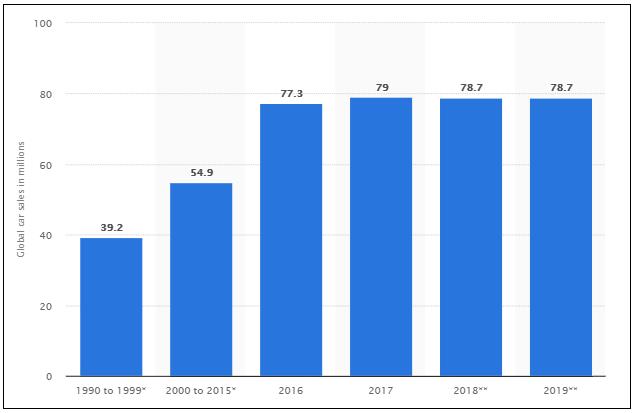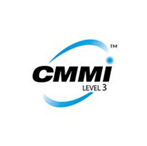
The automobile sector is one of the largest industrial sectors in the world. Its growth in the consumer market is tremendous. In fact, in 2018 alone, around 79 million cars were sold worldwide. Around the same amount of sales are expected to occur by the end of this year.

Figure: Statistics associated with car sales from 1990 to 2019
Various automobile companies are always in search of modern technologies that they can use in order to drive more sales and increase the production rate on assembly lines.
Augmented Reality in the automobile sector has brought in various benefits in term of production, maintenance, and industrial training. The advantages offered by augmented reality and other similar technologies in the field of automobile are tremendous.
Virtual Reality is a different technology than AR that immerses a person into a virtual environment instead of overlaying a series of virtual content over the real world. In the virtual environment, the person can interact with digital objects.
VR simulates a virtual environment that a person can enter into with the help of VR headsets. Audio and interaction devices make the simulation even more real and impart the feeling of actually being present in the real world.
With its feature of complete immersion and virtual interaction, VR is one other technology that is been used by several automobile industries to boost the performance of their vehicles and improve their production rate.
- Designing And Virtual Modeling:
The vehicle design process is one of the most expensive and time-consuming processes that requires a lot of continuous improvements, reviews, and testing.
The design is then tested using various simulation software in different conditions. The design can get canceled if it fails in any design specification/criteria or design testing.
If the design gets canceled, the designer may have to make various modifications and start the designing process afresh.
Thus, vehicle designing is a nerve-wracking process that requires multiple mock-ups, endless modifications, and frequent fluctuation between various design decisions. This significantly raises the project cost.
Automobile giants like Chevrolet and Mercedes, spend a tremendous amount of their budget on vehicle designing to develop vehicles that can catch the eye of customers instantaneously.
By designing their concepts in virtual reality, car manufacturers can cut their cost associated with car designing and reduce time-related to physical mockups and modifications.
Designing is simple in virtual reality and improvements can be made in the existing prototype of the design. It also allows team members from different corners of the world to combine their skills in order to design a vehicle.
- Virtual Showrooms:
People often tend to visit a showroom before buying a vehicle. They go through different features of a vehicle and sometimes also take a test drive before finalizing a vehicle to purchase.
With the help of virtual reality, they can now do all these things from the comfort of their homes.
Car dealers often only have a few models with them and sometimes the characteristics of these models are different then what a buyer may expect. Also, buyers are often presented with a single color or set of features. The same goes for the interior and exterior.
They are often compelled to choose from a prospectus and see how their car looks when they finally acquire it.
Within a virtual environment, a customer can customize and explore different car models in different colors and features. They can customize a car model in the way they want to purchase it.
Using various HMD’s and haptic devices a consumer can enter a vehicle and take its test drive. Virtual Reality will also help dealers to easily present the vehicles in a virtual showroom.
Virtual showrooms can be easily implemented and dealers no longer will need to rent large places to store vehicles. Some big names in automobile manufacturing like Audi, are using VR in their dealership to provide their customers with a simple yet unique way to present vehicles to a customer.
- Industrial Training:
Virtual Reality is an amazing platform to learn new things. VR offers stunning advantages in the field of education.
The education benefits of virtual reality can also be used in the field of industrial training. Employees can be encouraged to improve their skills and proficiency in the field of assembly, manufacturing, repairs, inspection, and maintenance.
By practicing their skills in virtual reality employees can improve their efficiency on the assembly lines. This will help automobile companies to boost up their production rate.
Also, by letting their employees train in virtual reality, companies can reduce the cost associated with machine malfunctions and tool failures which is the most likely case in traditional training methods.
CONCLUSION:
Virtual Reality offers a wide range of applications in the field of automobile. By utilizing its benefits, the automobile industry has the opportunity to grow and develop innovative vehicles at a rapid production rate.












